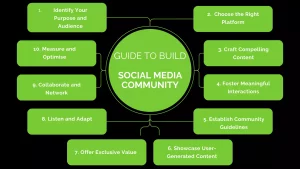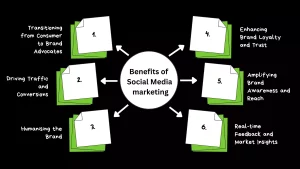Guide To Build Community For Strong Social Media Presence
When you build community, you connect with like minded people!
It is like creating a virtual space where individuals can easily find others who resonate with the ideas, hobbies, and causes.
Community making on social media platforms started in the early 2000s. These platforms allowed users to connect and share content with others. Soon in 2004 with Facebook Community launch, the feature really took off. And since then other platforms also adopted the benefit to foster online communities.
Let us understand the dynamics of the social media community in detail.
What is Social Media Community?
A social media community refers to individuals who come together on digital platforms, like Facebook, Twitter, or Instagram, around a shared interest, topic, or goal. This virtual gathering is a hub where people interact, engage, and connect based on shared passions or objectives.
Guide To Build Community For Social Media

The dynamic process of creating a powerful social media community calls for planning, commitment, and a thorough knowledge of your target market. This thorough manual will walk you through the process of building a flourishing online community that encourages interaction, cultivates bonds, and increases the effect of your business.
Step 1:Identify Your Purpose and Audience
Before you start, define the purpose of your community. What interests, values, or goals will bind your members together? Understand your target audience’s demographics, preferences, and pain points to tailor your community’s content and interactions.
Step 2: Choose the Right Platform
Select a social media platform that aligns with your community’s nature. Different platforms attract different audiences and content types. For professional discussions, consider LinkedIn. For visually-driven communities, Instagram or Pinterest might be suitable.
Step 3:Craft Compelling Content
Create content that resonates with your community’s interests. Share informative articles, engaging videos, captivating images, and thought-provoking questions. Consistency is key; develop a content calendar to maintain a regular posting schedule.
Step 4:Foster Meaningful Interactions
Encourage conversations by asking open-ended questions, running polls, or hosting live sessions. Respond promptly to comments and messages to show that you value your community’s engagement.
Step 5: Establish Community Guidelines
Set clear guidelines to ensure a positive and respectful environment. Outline rules for interactions, content sharing, and addressing conflicts. Enforce these guidelines consistently to maintain a safe space for members.
Step 6: Showcase User-Generated Content
Highlight content created by your community members. This fosters a sense of ownership and pride while providing fresh perspectives and varied content.
Step 7: Offer Exclusive Value
Provide exclusive content, discounts, or early access to members. This incentivizes participation and makes members feel special and appreciated.
Step 8: Listen and Adapt
Regularly gather feedback from your community. What do they enjoy? What can be improved? Adapt your strategies based on their input to continually enhance their experience.
Step 9: Collaborate and Network
Collaborate with influencers, experts, or other communities to expand your reach. Cross-promotions and partnerships can introduce your community to new audiences.
Step 10: Measure and Optimise
Use analytics tools to track engagement metrics such as likes, shares, comments, and growth rates. Analyse what works and what doesn’t, then refine your approach accordingly.
Benefits of Social Media Community

Let us read the reasons why is community important?
- Enhancing Brand Loyalty and Trust
A well-nurtured social media community acts as a magnet for brand loyalists. By fostering interactions and engagement, brands can solidify their presence in the hearts of their customers. Regular updates, timely responses to queries, and valuable content distribution create a sense of trust. Apple, for instance, has mastered the art of building an ardent community through its customer-centric approach, resulting in unwavering loyalty. - Amplifying Brand Awareness and Reach
The ripple effect of a vibrant social media community is far-reaching. When community members engage with content, they expose the brand to their networks, expanding the potential reach exponentially. Nike’s “Just Do It” campaign resonated deeply with its community, prompting users to share their fitness journeys. This not only amplified brand awareness but also inspired a movement, all while staying true to Nike’s values. - Real-time Feedback and Market Insights
The interactive nature of social media communities provides an invaluable platform for brands to gather real-time feedback. This dynamic feedback loop aids in understanding consumer preferences, pain points, and emerging trends. Starbucks, for example, constantly refines its offerings based on the input received from its engaged social media community, ensuring it stays ahead of the curve. - Humanising the Brand
Social media communities facilitate direct, person-to-person interactions. This humanises the brand, making it relatable and approachable. Wendy’s witty and humorous interactions with its community members exemplify this approach. By infusing personality into their responses, Wendy’s transformed mundane interactions into delightful conversations, enhancing brand memorability. - Driving Traffic and Conversions
A robust social media community is an effective conduit for driving traffic to the brand’s website or e-commerce platform. Through strategic content placement and calls to action, brands can guide community members toward desired actions. Fashion retailer ASOS proficiently directs its community to its website through visually appealing content, resulting in increased conversions. - Transitioning from Consumer to Brand Advocates
Social media communities have the potential to turn loyal consumers into passionate brand advocates. When customers feel a strong sense of belonging, they willingly champion the brand within their circles. GoPro’s community is a prime example, with users sharing their exhilarating experiences captured using GoPro cameras, inadvertently creating a legion of enthusiastic brand ambassadors.
Social Media Community Management Strategies for Success
Managing a community is important to keep the audience engaged.
Out of Sight is Out of Mind!
You can follow these strategies for social media community management strategies:
- Choose the right social media platforms. Social media sites are not all made equal. specific firms or industries are better suited to specific platforms than others. Find out which platforms are most popular with your target market by conducting some research.
- Create high-quality content. The most crucial element of your social media marketing plan is your content. It needs to be eye-catching, interesting, and educational.
- Be consistent. In order to keep your audience interested on social media, you must update frequently. Aim to post once per day, if not more frequently.
- Engage with your audience. Don’t simply post and then ignore it. Spend some time enjoying, commenting on, and responding to your audience’s posts.
- Track your results. It’s critical to monitor your progress so you can identify what is and isn’t working. Track your website traffic, social media interaction, and other metrics with analytics tools.
Also Read : Social Media Community Management: Everything You Need to Know About
Conclusion
Effective community management cultivates loyalty, amplifies brand reach, and fosters lasting connections. Remember, the heart of every community is its people, so engage authentically, empower users, and adapt to their evolving needs.
Looking to elevate your social media community? Our expertise would help you build communities and create engaging content that can elevate your brand’s online presence. Contact us at hello[at]noboruworld.com to shape a vibrant and connected community together.
FAQ
What is a social media community, and why is it essential for brands?
A social media community is a group of individuals who share common interests and engage in discussions on platforms like Facebook, Twitter, and Instagram. It’s crucial for brands because it allows them to build strong relationships with their audience, foster loyalty, and gather real-time insights to enhance their offerings.
How can brands encourage engagement within their social media community?
To encourage engagement, brands can create compelling and relevant content, ask thought-provoking questions, run contests or giveaways, and respond promptly to comments and messages. Branding can boost interaction and participation by fostering a sense of belonging and valuing community members’ input.
What role does user-generated content (UGC) play in a social media community?
User-generated content involves content created and shared by community members about a brand. UGC serves as an authentic endorsement, building trust among potential customers. Brands can encourage UGC by featuring customer stories, photos, and videos, thereby showcasing the real-life impact of their products or services.
How can challenges within a social media community be effectively managed?
Challenges within a community can be managed by addressing them transparently and professionally. Brands should promptly respond to negative comments or feedback, offer solutions, and show empathy. Handling challenges openly demonstrates a commitment to customer satisfaction and can turn negative experiences into positive outcomes.
Also Read – Social Media Community Guidelines



